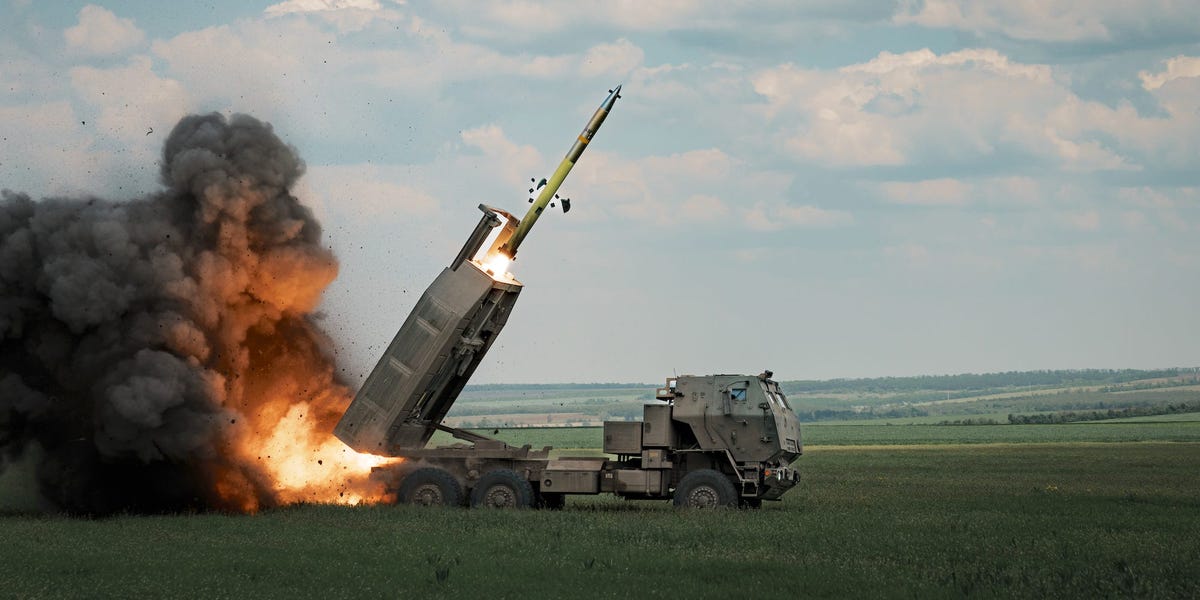- ATACMS and new drones would allow Kyiv hit all Russian positions in Ukraine, a retired US general said.
- The Biden administration has been reluctant to send longer-range missiles and drones to Ukraine.
- Retired Lt. Gen. Ben Hodges told Insider that Washington is likely concerned about Russian escalation.
The Biden administration has so far been reluctant to send long-range missiles and advanced drones to Ukraine, fearing that these assets could be used to hit targets within Russia’s internationally recognized borders and spark a dangerous escalation from Moscow.
But weapons like the Army Tactical Missile System (ATACMS) and Gray Eagle drones would increase Kyiv’s range of attack and boost its firepower, posing a threat to any Russian base or ammunition depot that’s inside occupied Ukrainian territory, a retired US Army general said, as videos of a drone attack on a Russian ammunition depot circulated.
Ben Hodges, a former lieutenant general who headed US Army Europe, told Insider that ATACMS missiles — which boast an impressive range of 190 miles — and advanced Gray Eagle drones, “put every headquarters and logistics site at risk” by allowing Ukraine to hammer Russian positions behind its Moscow’s extensive defensive lines . Gray Eagle drones, meanwhile, have an endurance time of around 25 hours and can operate at just shy of 30,000 feet, making them useful for longer missions.
Ukrainian forces have been pressing forward with their grinding counteroffensive for several weeks now, advancing in several directions along a sprawling front line across eastern and southern Ukraine and making small territorial gains in the process. But officials in Kyiv have indicated that the military still needs long-range strike capabilities to inflict damage on Russian troops beyond what it’s currently capable of.
ATACMS in particular could make it easier for Ukraine to target the occupied Crimean peninsula and Russia’s Black Sea Fleet. For example, Hodges said, if these missiles are fired from the southern Ukrainian city of Odesa, they could strike Moscow’s warships in Sevastopol.
Despite growing pressure from Congress and abroad, the Biden administration has yet to budge on ATACMS, although the Wall Street Journal reported last week that there appeared to be some movement toward providing the missiles. When asked later about ATACMS during a briefing, Pentagon Press Secretary Air Force Brig. Gen. Pat Ryder said he has nothing to announce and isn’t “aware of any imminent decisions as it relates” to the weapon.
Chairman of the Joint Chiefs of Staff Gen. Mark Milley said at an event last week that although “these things are on the table,” there have not been any decisions yet.
The strength of systems like ATACMS, which can be fired from Ukraine’s existing inventory of US-provided High Mobility Artillery Rocket System (HIMARS), is that they can bruise Russia’s logistics capabilities. “The Russians have more mass, more bodies, and more artillery. And it’s a very centralized system of command and control. So, the way you neutralize the only advantage the Russians have is by destroying headquarters and logistics site,” Hodges said.
ATACMS would also extend Ukraine’s reach beyond what it currently enjoys with its UK-provided Storm Shadow missiles. These fearsome weapons, which have been championed by officials for their battlefield success, have an operational range of 155 miles — more than three times the distance of HIMARS and Guided Multiple Launch Rocket System (GMLRS).
Although these weapons have proven to be beneficial, Hodges said that they’ve also given Russian forces beyond the attack range a degree of comfort. “Because we, the US, have continued to refuse to provide ATACMS, we have, in effect, created a safe haven for the Russians inside Ukraine. Anything that is beyond the current GMLRS, HIMARS, and Storm Shadow is in effect, safe haven,” he added.
The Biden administration’s apprehension to sending ATACMS to Ukraine is partially due to fears of Russian escalation — the same concerns that have led to flip-flopping on giving Ukraine other systems like American-made Abrams tanks and F-16 fighter jets . Months of pleading by the Ukrainians — and pressure from US partners — eventually led to Washington’s decision to supply Kyiv with the advanced tanks, and authorize the export of F-16s from European allies.
It’s unclear when, exactly, Ukraine will be armed with these fighters — the details and timeline of Ukraine’s F-16 training remain somewhat murky. Armed with the right missiles though, these aircraft could help prop up Ukraine’s air defense and allow its air force to inflict damage on Russian positions from far ranges.
For now, it remains to be seen what additional long-range weapons the West will provide to Ukraine, which can likely expect new announcements on security assistance at the upcoming NATO summit next week. Although Kyiv has repeatedly assured Western capitals that it wouldn’t use long-range assets to hit targets inside Russia, endless nuclear saber-rattling from Russian President Vladimir Putin has still kept Kyiv’s military backers on edge.
The Russians “see that we are self-deterring over the possibility that they might use a nuclear weapon,” Hodges said. But Moscow has threatened to use nuclear weapons since nearly the beginning of the full-scale invasion last year, and the weapons are “really only most effective when they don’t use them.”

